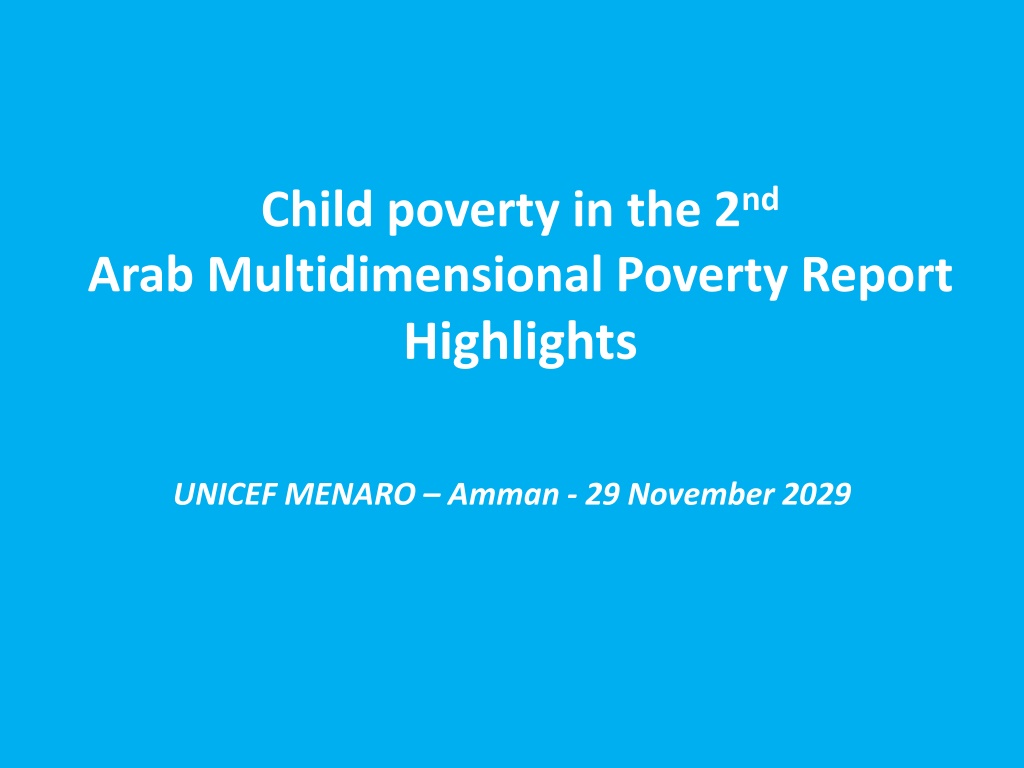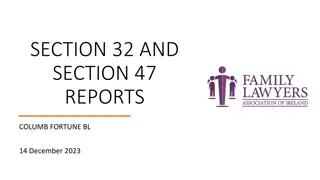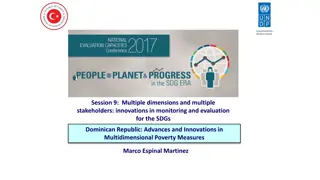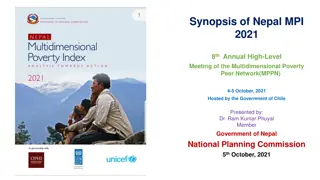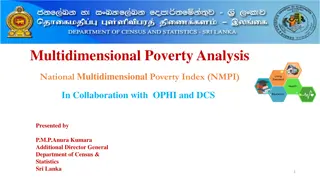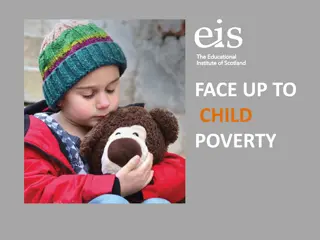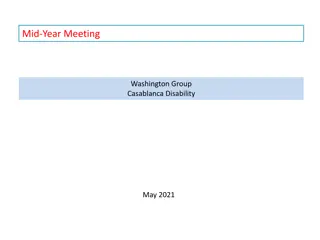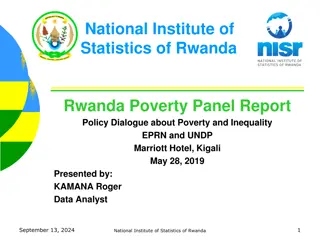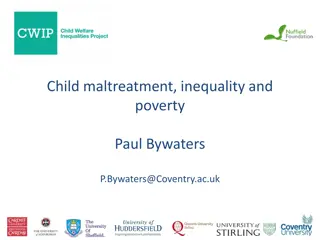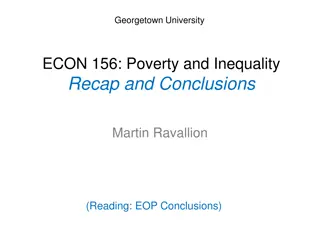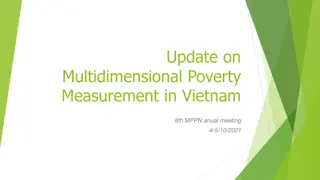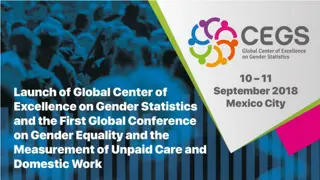Understanding Child Poverty in the Arab Region: Insights from the Arab Multidimensional Poverty Reports
The Arab Multidimensional Poverty Reports shed light on child poverty, emphasizing the importance of focusing on children's well-being alongside household-level measurements. The reports utilize the Arab-MODA framework to measure child poverty, assessing various dimensions such as health, education, nutrition, water, sanitation, and housing. By adopting a child-centric approach, these reports aim to address the unique challenges faced by children in poverty, ensuring their rights and well-being are safeguarded.
Download Presentation

Please find below an Image/Link to download the presentation.
The content on the website is provided AS IS for your information and personal use only. It may not be sold, licensed, or shared on other websites without obtaining consent from the author. Download presentation by click this link. If you encounter any issues during the download, it is possible that the publisher has removed the file from their server.
E N D
Presentation Transcript
Child poverty in the 2nd Arab Multidimensional Poverty Report Highlights UNICEF MENARO Amman - 29 November 2029
The Arab Multidimensional Poverty Report First Arab Multidimensional Poverty Report 2017, a cooperation between UNESCWA, LAS, UNICEF and OPHI Regional initiative to measure progress towards the SDG 1.2.2 Arab Strategic Framework for the Eradication of Multidimensional Poverty (2018-19) Plan for regular updates of the multidimensional poverty analysis Second Arab Multidimensional Poverty Report expanded partnership (+ UNDP and UNFPA) Report Launch January 2023 at the Arab Ministerial Forum of Social Development Ministries.
Child poverty in the Arab Poverty report The 1st Arab Poverty Report recognizes the importance of having a specific focus on children, along with the household level measurement (assessed through the Arab-MPI). Child poverty is different from adult poverty (and different are their consequences). Poverty measured at the household level may hide childhood poverty (complementarity of household-level and child- level measurements). Importance of having a measure with the child as unit of observation/measurement and based on the constitutive rights of poverty (material deprivation), grounded on the Convention on the Rights of the Child.
The Arab-MODA approach to measure child poverty Based on the global Multidimensional Overlapping Deprivation Analysis (MODA) approach developed by UNICEF in 2012 Adapted to the Arab context: Parameters defined reflecting those used in national child poverty measurement in Arab Countries [11] Deprivation thresholds defined to reflect the socio-economic contexts of the Arab region Focus on children aged 0-17 (with 2 sub-groups, children 0-4 and children 5-17) A child is considered multidimensional poor if deprived in at least two essential dimensions of well-being Statistics generated for children as individuals, and not for households
The Arab-MODA framework Children 0-59 months Children 5-17 years Dimension Indicator Dimension Indicator Health No skilled birth assistance Education Not enrolled in school No-ante natal care Two or more grades behind school or did not complete primary (from age of end of primary to 17) Not fully immunized Nutrition Inadequate infant and young child feeding No access to any information device Information Wasting No access to any communication device Stunting Water No piped water inside the dwelling Obesity Sanitation Unimproved toilet facility Water No piped water inside the dwelling Shared toilet Housing Sanitation Unimproved toilet facility Overcrowding Shared toilet Poor floor & roof material Housing Overcrowding Poor floor & roof material
The child population in the Arab MICs covered in the analysis Table 1 Child population in the selected Arab Middle-Income countries (2020) 7 Arab Middle- Income countries are covered by the analysis of child multidimensional poverty 0-17 years old as a share of the Share in the total child population of the seven countries Child population 0-4 years 5-17-year- 0-17-year- total old olds olds population of each country (in thousands) 5,042 12,697 5,380 1,058 % % Algeria Egypt Iraq Jordan 10,250 27,291 12,322 2,931 15,292 39,988 17,702 3,989 34.9% 39.1% 44.0% 39.1% 16.2% 42.3% 18.7% 4.2% Available data covers slightly less than 95 million children, around 57% of the regional population aged less than 18. Morocco 3,381 8,490 11,871 31.6% 12.6% Palestine 693 1,579 2,272 44.5% 2.4% Tunisia Total 1,004 29,255 2,340 65,203 3,344 94,458 28.3% 37.6% 3.5% 100.0% Source: UN Population Division
Prevalence of child multidimensional poverty in 6 MICs, in the mid-to-late 2010s 50 Overall, in the 6 MICs covered by the analysis, 22.9% of children are deprived in at least two essential dimensions of their well-being % of children in multidimensional poverty 40 33.2 30 22.9 19.3 Around a child out of three in the age group 0-4 lives in multidimensional poverty 20 10 Pre-covid situation, many dimensions likely affected by the socio-economic impacts of the pandemic 0 Total children 0-17 years Children 0-4 years Children 5-17 years Country coverage: Algeria, Egypt, Iraq, Jordan, Morocco and Tunisia
% of children deprived in the different dimensions of well-being, 6 MICs, mid-to-late 2010s Still around one-third of children under-5 are deprived in the nutrition (inadequate diets, stunting, wasting and obesity) 50 % of children deprived in each dimension 40 36.2 34.1 30 A similar proportion of children under-5 is deprived in health (with growing numbers of children not completely immunized) 25.0 22.1 18.2 20 10 6.7 5.1 Almost one school-age child in five is deprived in education. 0 Nutrition (0-4 years) Health (0-4 years) Education (5-17 years) Information (5-17 years) Water (0-17 years) Sanitation (0-17 years) Housing (0-17 years) Nutrition, health and education are the dimensions most likely affected by the socio-econ consequences of COVID-19
Changes in the prevalence of multidimensional child poverty in 6 Arab MICs, from early to mid-to-late 2010s 50 % of children living in multidimensional poverty 42.6 41.8 38.2 40 30.7 28.1 27.8 30 24.3 23.9 22.9 22.2 18.8 20 16.8 16.6 13.9 10 0 2012 Recent 2019 2008 2014 2011 2018 2011 2018 2018 2012/13 2017/18 2011/12 Baseline Algeria Egypt Iraq Jordan Morocco Tunisia Average
Disparities in dimensional child poverty within countries mid-to-late 2010s The analysis confirmed the marked disadvantage of children living in rural and remote areas (see fig.), but with notable signs of improvement over time. Other factors strongly associated with multidimensional child poverty are the household wealth, the level of education of the head of the hh (when it is below the secondary school) and the household size (more than 3 children in the hh) The association between the sex of the hh head and poverty is not emerging strongly.
Multidimensional child poverty in the State of Palestine (using the Arab MODA framework) Decline in child poverty prevalence (but virtual stagnation since 2014) % of children living in multidimensional poverty 40.4 39.0 40.0 32.9 31.4 Highest rates in refugee camps, followed by urban areas 30.0 18.7 20.0 Highest levels of deprivation in water (46%). One child in five deprived in the nutrition dimension, and a similar share deprived in health. 10.0 0.0 0-17 y.o. urban rural refugee camps 2010 2019-20
Adding the MENA low-income countries to the picture 100 87.0 90 % of children living in multidimensional poverty 76.3 80 70 60 50 42.6 41.8 39.0 38.2 40 31.4 28.1 27.8 30 24.3 23.9 22.2 18.8 16.8 16.6 20 13.9 10 0 n/a n/a 2012/13 2017/18 2019/20 2011/12 2019 2008 2014 2011 2018 2012 2011 2018 2010 2018 2013 2013 Algeria Egypt Iraq Jordan Morocco State of Palestine Tunisia Sudan Yemen
Adding the MENA low-income countries to the picture / 2 100% 83% Early 2010s Late 2010s multidimensional poverty % of children living in 80% 60% 45% 40% 31% 24% 20% 0% MENA MICs (7) MENA LICs (2) Total - 9 MENA countries (MICs and LICs) 60 % of children in multidimensional poverty by type of residence 50 48.9 43.7 40.4 40 39.7 33.2 32.9 30 28.4 20.5 20.1 20 19.2 18.7 13.2 11.1 10 9.6 9.2 0 Algeria (2019) Egypt (2014) Iraq (2018) Jordan (2017-18) Morocco (2018) State of Palestine (2019-20) Tunisia (2018) National Average Urban Rural Palestinian refugee camps
Elements for reflections Importance to keep a child focus, with a complementary and distinct child-centred measure of multidimensional poverty Despite important progress, around one child in four in Arab MICs was living in multidimensional poverty towards the end of the 2010s. Heterogeneity between MICs (headcount ratios ranging between 13% and 38%). The large majority of children in Arab LICs are multidimensional poor (around 80%) The situation has likely deteriorated since then due to compounding crises (COVID-19, Ukraine war, conflicts etc.) Part of the progress in the 2010s is due to the reduction of inequalities. Still, they are persistent, especially between urban and rural areas, wealth quintiles and other socio-economic characteristics Some common implications focusing on nutrition, access to health, education, equity in access to social infrastructure, reduction of inequalities
Thank you The second Arab Multidimensional Poverty Report is available at: https://www.unescwa.org/pub lications/second-arab- multidimensional-poverty- report
Annex Status of multidimensional poverty measurement and analysis in MENA countries
The status of child poverty measurement in the MENA region 11 countries in the MENA region (out of 20) have carried out multidimensional child poverty measures (challenges, concerning: continuity in measurement, institutionalization in the context of monitoring the SDGs - inclusion in the NRV / national ownership) 2017 - Conference on Measuring Child Poverty in the MENA Region 2018 - Publication of the 1st report on child poverty in Arab countries (UNICEF, ESCWA, League of Arab States), using the MODA approach 2020 - Simulation analysis of the impact of COVID-19 on multidimensional child poverty 2023 - 2nd report on child poverty in Arab countries (UNICEF, ESCWA, League of Arab States)
The status of multidimensional child poverty measurement in the MENA region Country Status of the Measurement Algeria Measurement fully owned by national institutions (2019) and child multidimensional poverty reported in VNR update of the measurement finalized in 2022 and report under review Djibouti Egypt 4 studies using different methodologies, conducted with the national institutions. 2016 study with MoSS and CAPMAS. New measurement under finalization with MoPAD Iran Measurement conducted by the Government Iraq 2 studies using different methodologies most recent finalized in 2022 internal discussion to review the approach and the process (using MICS 2024) Jordan DoS approached to proceed with a national measure of multidimensional poverty for children, using the 2023 DHS data
The status of multidimensional child poverty measurement in the MENA region Country Status of the Measurement Lebanon Qualitative study on child multidimensional poverty conducted in 2022 plan to produce a measure of MDCP with national partners in 2024, with the data of the new MICS Libya Child poverty measurement produced by UNICEF in partnership with national institutions, completed in 2022 not institutionalized Morocco 2 measures of multidimensional child poverty conducted with national partners (ONDH) in 2017 and 2022 report under finalization Palestine Measurement done in 2017 not approved by national partners National process for producing a new child multidimensional poverty measures under discussion with MoDS, PCBS and Prime Minister Office Sudan Tunisia National measurement of child multidimensional poverty produced by UNICEF with national partners 2 reports, 2017 and 2022 used in VNR, but not institutionalized discussion ongoing on institutionalization Yemen Preparatory work for a process of establishing a measure using MICS
